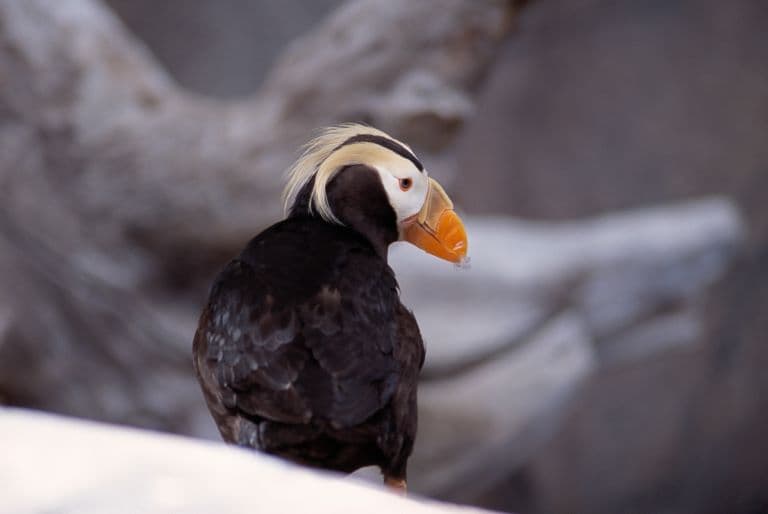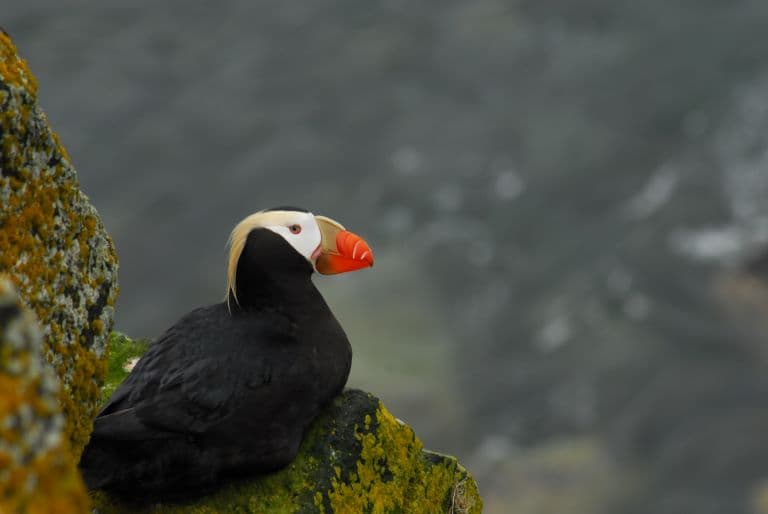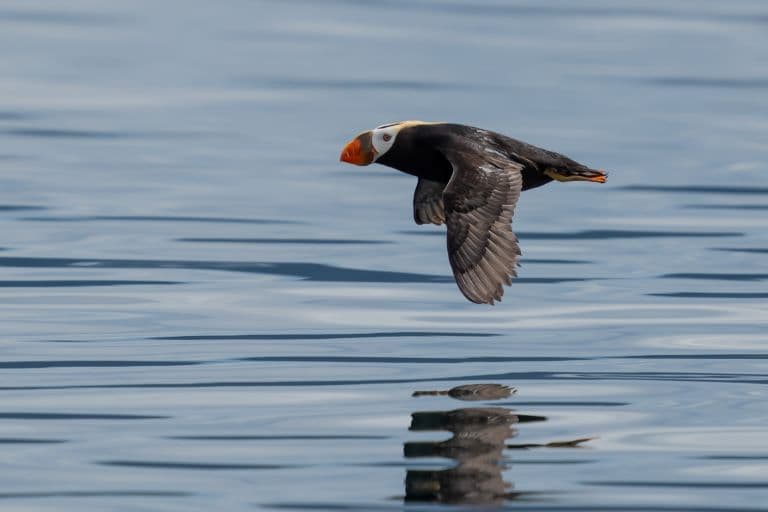Tufted Puffin Profile
Most baby birds are brought up on a healthy diet of puke.
Feathers don’t come with pockets, so adult birds fill up on food and begin the digestion process on the way home, after which they’ll regurgitate into the eager beaks of their kids. Gross.
Puffins are a lot more refined in their practices and will drape dead fish over their beaks and carry them home intact. Many species can carry up to 20 fish. But the tufted puffin blows even its closest relatives out of the water.

Tufted Puffin Facts Overview
| Habitat: | Pelagic, but nesting on island or coastal cliffs, rocky areas, open ocean |
| Location: | Coastal North Pacific |
| Lifespan: | Six years |
| Size: | 35 cm (14 in) long |
| Weight: | 750 g (1.6 lb) |
| Colour: | Black with a white facial patch and red or orange beak |
| Diet: | Fish and invertebrates |
| Predators: | Raptors, gulls, arctic foxes |
| Top Speed: | Unknown |
| No. of Species: | 1 |
| Conservation Status: | Least Concern (IUCN) |
The tufted puffin is one of the largest of its kind and an open ocean specialist that spends the majority of its time hunting out to sea. When nesting, it gathers in large social groups, where it digs burrows and engages in ritual combat.
These are pretty successful birds, even though they make good jackets and have suffered at the hands of the fishing industry. Today they’re still thriving and can be seen carrying a mouthful of fish back to their babies.
Interesting Tufted Puffin Facts
1. They’re Alcids
Alcids, or Auks, are a family of birds from the order that contains the gulls, terns and plovers. But unlike most in this order, the Alcid family are stocky animals, and many are even penguin-like in appearance, such as the guillemots and murres.
Since the extinction of the great auk, the Puffins are perhaps the most penguin-like of the lot, and of the puffins, the tufted puffin is the largest.
2. They spend most of their time at sea
Tufted puffins also stand out as the most pelagic of the auks, and after the nesting period is over and done with, will spend the rest of their time out to sea.
Most of this time is spent over the Pacific Ocean, where they’re rarely seen, but being unable to reproduce in water, they do have to return to land eventually.

3. But nest in burrows
Nobody’s quite sure how they find their way back, but they do. And in greater numbers. Large colonies of puffins can be found nesting in burrows, dug into grassy areas and cliff faces along the edge of the sea.
Islands are a preferred habitat, as they reduce the through-traffic of potential predators, and inside these secluded tunnels, each female will lay a single egg.
Incubation takes between 40 and 54 days, after which the parents will have to go out and fetch lunch for their offspring until they fledge.
4. They can carry a lot of fish
Puffins are excellent at catching fish and can do so by flying low and dipping into the ocean itself with their mouths open.
The huge beaks they carry around are the best at carrying fish, and while puffins are known to bring back up to ten fish in their beaks at once, the tufted puffin has been seen carrying up to 60 in a single trip.
This impressive skill allows them to avoid the awkward method that many birds use, of puking up half-digested fish into the hungry mouths of their own children.
They don’t catch them all at once, instead, they use their tongues to pin their last catch to the roof of their mouth while they go back to grab some more. 1 2
5. They’re tough little birds
This tenacity tracks well with puffin attitudes. Tufted puffins are gregarious and highly social and come with the relevant skills in conflict resolution.
They’ll grapple and kick anyone who tries to enter their burrow, and when a pair of them get into a squabble they’re not above a bit of wrestling with their mouths open.
These events can be the highlight of the breeding season for their conspecifics, who will often gather around a battle and watch.
After breeding is finished, these tough little birds will overwinter in the ocean! They’re able to drink sea water for hydration and their incredible feathers are so good they don’t freeze.
Unfortunately for the puffin, this did not go unnoticed.

6. They make good parkas
North Pacific tribal peoples have traditionally hunted this species for its fantastic jacket.
It’s also large enough to make a decent meal, and while the hunting of the species is now illegal, its skins were once used to make tough and very warm parkas, which were worn with the feather side inwards.
The silky tufts that give this bird its name were also coveted as an accessory that was sewn into the jacket. Even the beaks were used, made into hand rattles and decorative ceremonial additions to aprons.
Being a large species, it only takes 45 puffin skins to make a decent parka, but this is something that’s frowned upon nowadays. 3

7. They do have some threats
This species is caught as bycatch by fisheries and invasive rats threaten their reproductive success, as does the impact of climate change on their habitats.
Oil spills can be particularly damaging to animals that spend as much time at sea as these little guys, but despite all the potential risks, this species is doing remarkably well.
The population sits at around 3 million, with more than 80% of these found in North America, predominantly Alaska.
With such remote and plentiful populations, the tufted puffin is currently listed as of Least Concern by the IUCN. 4

Tufted Puffin Fact-File Summary
Scientific Classification
| Kingdom: | Animalia |
| Phylum: | Chordata |
| Class: | Aves |
| Order: | Charadiiformes |
| Family: | Alcidae |
| Genus: | Fratercula |
| Species: | cirrhata |
Fact Sources & References
- , “Fratercula cirrhata tufted puffin”, Animal Diversity Web.
- “Tufted Puffin”, Cornell Lab.
- (2018), “Tufted Puffin”, Eastside Audubon.
- “Tufted Puffin”, IUCN Red List.
